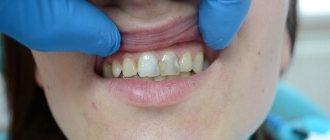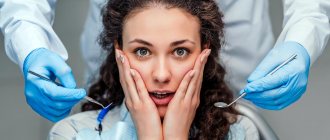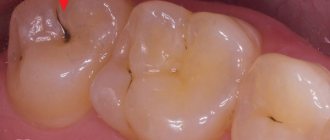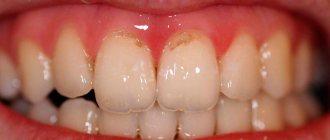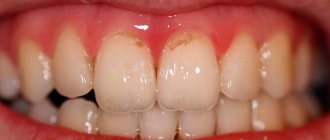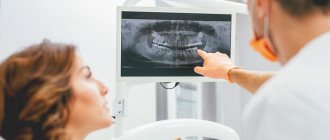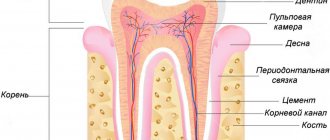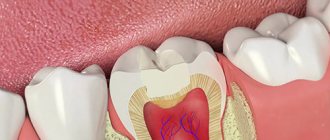Most patients who come to see a dentist require treatment for caries. Sometimes a person complains about other problems or asks to have his teeth fixed, but during an examination of the oral cavity, areas of destruction of enamel and dentin are discovered. Therefore, both dental alignment and prosthetics or implantation are often preceded by therapeutic procedures.
Modern treatment of caries
Thanks to the constant improvement of techniques, today the diagnosis and treatment of dental caries is carried out at a high level, which allows for maximum preservation of healthy tissue. In addition, in situations where just a few years ago advanced caries led to mandatory tooth extraction, today tooth-preserving operations are performed. Among them are the following.
- Resection:
treatment of tooth root caries by removing the apex of the root. - Root amputation:
removal of the damaged root part of a two-rooted or three-rooted tooth. - Coronoradicular separation:
separation of tooth roots. It is carried out when caries has affected the tooth in the area of root branching. - Hemisection:
removal of the damaged part of a multi-rooted tooth and the adjacent crown area.
How to treat caries using traditional methods
Of course, it will not be possible to cure even average caries using traditional methods; you can only temporarily relieve the pain while you wait for an appointment with a doctor.
For this you can use:
- saline mouth rinse;
- camphor alcohol - by moistening a cotton swab with it, you can wipe not only the sore tooth, but also the gum near it;
- fir oil - a swab moistened with it should be placed on the tooth and adjacent gum and held for half an hour;
- alcohol infusion of horseradish - grate the horseradish, pour in vodka, leave for a couple of days, strain and apply a swab moistened with it to the sore tooth for ten minutes;
- infusion of onion peels - take a few spoons of onion peels, pour boiling water, leave for 24 hours, strain and rinse the mouth several times a day;
- garlic juice - get garlic juice using a blender or a garlic press, moisten a tampon in it and apply it to the tooth for 10-15 minutes.
You can also use traditional methods to treat caries in the initial stage - the spot stage. Here they will come to the rescue:
- sage decoction: you can rinse your mouth with the prepared solution almost an unlimited number of times;
- infusion of raspberry and mint leaves: leave the chopped leaves in wine vinegar for three days, strain and rinse your mouth with the resulting infusion;
- chicory root: fresh root can be chewed, and dried, pour water, leave and rinse your mouth;
- laundry soap: prepare a solution of soap and water and rinse your mouth with it;
- propolis: place a piece of propolis on a sore tooth, press with a cotton swab and leave for a while.
Indications for the treatment of dental caries
Indications are reduced to visual and tactile.
✔
Visual:
stains on the enamel, darkening of the cervical area of the tooth, chipping of part of the tooth and darkening underneath it, a dark border around the perimeter of the filling, a carious hole.
✔
Tactile:
aching pain when eating sweet, salty and sour foods, and acute pain from sudden temperature changes.
How to diagnose and treat caries in teenagers
In order for your permanent bite to remain healthy throughout your life, you must initially carefully care for your oral cavity. Following simple but effective rules will allow your child to have a beautiful smile:
- Ensure thorough hygiene not only at home, but also by visiting a professional cleaning at the dentist;
- Come regularly to the clinic for examinations every 6 months. Being in the transition period, caries quickly develops in the mixed dentition, so control is needed;
- For prevention, it is recommended to seal fissures. A filling material is used whose active component is fluorine. The procedure allows you to close vulnerable areas of the tooth and at the same time strengthen the enamel.
Types of caries by localization
fissure
It begins in the physiological recesses of the chewing teeth - fissures. The patient cannot detect it during self-examination.
Approximal (or contact)
It begins on the contacting surfaces of adjacent teeth. As a rule, this is a consequence of not using floss or irrigator as part of hygiene.
Cervical
It begins at the base of the gum, gradually destroying the neck of the tooth. It is the result of severe tartar.
Interior
It begins under the tooth filling if errors were made during its installation.
Under the crown
It begins under the crown if it does not fit tightly to the tooth, causing microscopic food debris to accumulate.
Prevention of caries
Even strict adherence to hygienic rules for oral care does not mean that you can ignore visiting the dentist once every six months. Regular, thorough teeth cleaning alone is not enough; special professional cleaning is necessary to completely remove plaque and formed stones. The doctor also carries out a procedure that is effective for disease prevention to restore the mineral balance of tooth tissue. Remineralization increases resistance to disease and is a mandatory step in teeth whitening - before and after.
Of particular importance in preventive measures is the sealing of dental fissures. Today in dental practice, the use of sealants that cover fissures and blind dental pits is widely accepted. It is painless and is usually prescribed for children and adolescents.
Incorrect bite and misaligned teeth can also trigger the development of caries, so treating these deficiencies is not just a solution to the issue of attractiveness, it is a matter of dental health. It is necessary to consult an orthodontist and carry out treatment with him if necessary.
Types of caries according to severity
Initial caries
Characterized by a change in the color of the enamel: the so-called white spot caries. Does not cause discomfort to the patient.
Superficial caries
Characterized by the appearance of dark spots on the enamel. The affected tooth may react weakly to cold, sour or sweet foods for a short time.
Average caries
Characterized by destruction of dentin. Painful sensations to external stimuli are more pronounced and last longer.
Deep caries
Characterized by damage to a large area of tooth enamel and dentin. The pain does not go away without the use of analgesics.
Complications of caries
Most often, the cause of complications with dental caries is the person himself, however, improper treatment can lead to unpleasant consequences (which is why choosing a dental clinic is so important). The development of untreated dental caries leads to negative changes in the structure of dentin, it becomes infected, the pulp becomes inflamed (the disease is called “pulpitis”), which is accompanied by acute pain. However, pain occurs not only with inflammation of the pulp, but also with deep caries, since the pulp chamber is covered only by a thin layer of affected tissue, which cannot protect against mechanical pressure on the neurovascular bundle during meals.
Teeth can also hurt in the middle stage: the nerve endings in the area of the enamel-dentin line react to external influences, causing pain.
Deep infection often leads to complications. In some cases, phlegmons and abscesses develop, which pose a significant threat to the general condition of the patient, and sometimes even to his life. the body has to devote all its strength to fighting the source of infection, the immune system is weakened, which can lead to the occurrence of systemic diseases. In such situations, it is often necessary to resort to surgery to get rid of the purulent contents and prevent the infection from spreading further.
Modern methods of treating dental caries
Today, there are several methods for treating caries, differing in the degree of surgical intervention - the earlier the degree of development of the disease, the greater the likelihood that it will be possible to get rid of it with few sacrifices.
Modern technologies for treating caries without preparation:
- Remineralization:
a procedure for treating enamel caries, which involves treating the tooth surface with a solution containing fluoride, phosphorus and calcium. The patient is also prescribed a number of medications to take orally. Helps in the treatment of white caries, or caries in the spot stage. - Infiltration:
chemical-mechanical treatment is also a method of treating caries without preparing Icon. It is used for initial caries and only on smooth surfaces or between teeth. First, a gel is applied to the carious area, which splits the affected enamel; the site of bacterial development is dried under the influence of ethyl alcohol and an air stream and treated with a polymer resin, which fills the enamel pores. The entire procedure lasts about fifteen minutes. - Air abrasive treatment:
“knocking out” superficial caries using a powerful stream of abrasive particles. The force of action is designed to affect only soft tissues affected by bacteria. The method is painless, and therefore there is no need for anesthesia. Air abrasive treatment reduces the risk of microcracks forming after treatment, in some cases it is even more effective than a drill. However, this method of caries treatment is not always applicable. - Ozone treatment:
destruction of caries bacteria using a natural antibiotic and oxidizing agent - ozone. Another method of non-contact treatment of caries. Ozone not only suppresses infection, but also has a remineralizing effect on tissue. During the procedure, a special device converts ozone from oxygen and supplies it to the affected area. Ozone destroys bacteria and is converted back into oxygen. The technology for treating caries with ozone allows you to leave healthy cells intact. Another advantage is that there is no need for anesthesia. The treatment time for caries using this method is less than a minute. Like the previous one, it is suitable only in the initial stages of caries or as its prevention. - ART technique:
restorative therapy, during which, using a special instrument, the affected tissue is removed and the cavity is filled with special dental cement. This method of treating caries was invented in third world countries, where it was not possible to open full-fledged dental offices, but it is also used in developed countries. Completely manual work allows you to act carefully and preserve as much healthy tissue as possible. - Laser treatment:
an effective technique for eliminating superficial and intermediate caries (for example, in the treatment of dentin caries) using laser fluorescence. During the procedure, a bactericidal solution is used, which cools the tooth and reduces pain. In addition, laser devices do not produce vibrations, which could increase pain. That is why the laser treatment method is indicated primarily for children and pregnant women. The laser selectively acts on the affected area, “evaporating” it, and disinfects the resulting cavity, thus eliminating the risk of developing secondary caries. - Treatment of dental caries with diet:
a method of treating caries naturally, developed based on the scientific theory of the American researcher Ramiel Nagel. According to his observations, caries does not have an infectious-bactericidal nature, but is associated with the weakening and destruction of enamel due to a lack of necessary substances. Therefore, the problem can be solved with proper nutrition. Adherents of natural treatment recommend actively using cod liver, fish caviar, butter and other products containing fat-soluble vitamins, nutritious broths, as well as chicken, beef and fish. It is better not to overuse fruits - due to their high sugar content - and combine them with small portions of fat, such as cream.
What methods do dentists use to combat caries?
All methods of treating dental caries can be divided into two large groups - invasive and non-invasive. The first involves treating enamel caries without preparation. This option is most often used when the carious lesion is in its initial stage, there is no extensive damage to the deep tissues of the tooth, or there are indications for anesthesia.
Invasive technologies are used much more often and involve tooth preparation and removal of tissue affected by caries. The degree of preparation depends on how severely and deeply the tooth is affected.
The optimal treatment regimen and method is always selected by the dentist, taking into account age, individual characteristics, stage of disease development, anesthesia tolerance and other factors.
Classical treatment of caries in permanent teeth
In advanced cases, non-invasive treatment methods for caries will not help, so specialists turn to the old but effective removal of caries using drilling.
The procedure involves cleaning the affected canals using a drill; if dentin is damaged, pulp and infected tooth tissue can also be removed. It should be noted that the devices that are used for this today have gone far ahead of those that once brought fear to our grandparents. Anesthesia and disinfectants can reduce the pain effect and make the procedure more comfortable for the patient. To complete the treatment of caries, a filling or crown is placed on the tooth and adjusted so that the patient does not feel any discomfort.
Reasons for the development of the carious process
The development of caries largely depends on the individual characteristics of the body. For example, in women with hormonal imbalances, plaque accumulates on the teeth more often, which leads to an increased attack from bacteria. In general, caries is caused by pathological microorganisms, which become much more numerous in the oral cavity than good bacteria. And their appearance is caused by the following reasons:
- lack of proper hygiene: brushing your teeth for 20-30 seconds in the morning and evening is very little. Dentists' recommendations are at least 2 minutes twice a day, as well as removing food debris that accumulates in narrow spaces after eating. Gradually they transform into plaque, which is a provocateur of many dental diseases, including caries,
- poor nutrition: excessive consumption of sweet foods and changes in the PH composition of saliva - all this again contributes to the formation of plaque and an increased attack of bacteria,
- age: it has been established that the destructive processes of primary teeth actively develop in the first years of children’s lives. As you get older, the likelihood of developing dental diseases decreases. This is influenced by the fact that adults pay more attention to oral hygiene. In old age, the risk of caries increases again - this is the result of various diseases of the body and insufficient oral hygiene,
- pregnancy and lactation, that is, during those periods when a woman loses many vitamins and minerals, in particular calcium and fluoride,
- lack of vitamins and, as a result, increased fragility of tooth enamel,
- genetics: a predisposition to many diseases of the gums and teeth is passed on from parents.
Main stages of the procedure
If for caries in the stain stage, treatment comes down to brushing the teeth with a special brush, applying a remineralizing composition and taking medications to strengthen the enamel, then in later stages it is necessary to remove the affected tissue and fill the cavity. In this scenario, the principle of caries treatment is as follows:
- anesthesia;
- preparation of a carious cavity;
- removal of infected tissue;
- cavity treatment;
- tooth filling.
Caries treatment and filling are carried out in one appointment. If, during the treatment of caries, damage to the dental pulp is detected, it may require its removal.
Basic principles of cavity preparation
Preparing the cavity of a diseased tooth is one of the most important stages in the treatment of caries.
Modern methods require a special approach to the preparation of carious cavities. Professional dentists follow five basic principles when performing this procedure:
- Biological feasibility.
All dental tissue affected by caries must be excised.
- Gentle treatment of dental tissues.
The dentist chooses an approach to caries treatment that will maximize the preservation of healthy tissue.
- Compliance with aseptic and antiseptic requirements.
All instruments that come into contact with teeth, oral mucosa, saliva and blood must be sterile. If technologies are used that create aerosols in the air, it is necessary to use eye and respiratory protection.
- Painless manipulations.
Any painful interventions are carried out only with the use of anesthetic drugs. During the preparation process, the dentist observes a number of conditions that make cavity treatment minimally painful: he works only with sharp burs, prepares the cavity with intermittent movements, uses the air-water cooling method, uses high-speed tips, etc.
- Biomechanical compliance.
The shape of the carious cavity must correspond to the physical and mechanical properties of the filling material and dental tissues that surround the cavity.
Choosing a filling
Previously, mainly mineral cements, acrylic and epoxy, and amalgams were used to make fillings. Today, outdated fillings, which were imperfect in terms of fixation and aesthetics, have been replaced by modern inlays. They improve the adhesion strength to the tooth surface, do not require labor-intensive installation, and are biocompatible with the human body. Among them, the most used are: composites, glass ionomer cements, ormocers, compomers. Materials can be combined to achieve the desired effect.
Potential consequences and complications
The very question of whether caries should be treated is very dangerous. It is important to never doubt that treatment is necessary. Often a person observes the first symptoms of a problem, but begins to put off going to the dentist. The time for treatment is constantly being delayed more and more.
The main danger of this approach is the likelihood of complications. The most common among them is the appearance of periodontitis or pulpitis.
There are several of the most serious consequences of untreated caries:
- Tooth loss. If the tooth is severely damaged or the lesion has gone very deep, there is nothing left except surgical intervention.
- Pathological processes in the gums. They can lead to the need to remove not only the affected tooth, but also its completely healthy neighbors.
- Systemic complications in the functioning of internal organs. The gastrointestinal tract and immune system suffer greatly. It is important to understand that a sluggish inflammatory process has a sharp negative effect on the entire body and weakens it.
The question of how caries is treated in dentistry in children is always considered separately. It is necessary to solve the problem that has arisen with baby teeth, because advanced disease leads to pathologies in the formation of permanent dentition.
Is it possible to cure tooth decay at home?
Treatment of dental caries at home is impossible. However, this disease is preventable. To do this, you should regularly perform oral hygiene using calcium and fluoride toothpaste, visit the dentist twice a year and ensure that your diet contains enough proteins and fewer carbohydrates. For additional protection, you can apply gels to strengthen tooth enamel, which will saturate the teeth with minerals - they are not a cure for caries, but will help reduce the risk of developing the disease.
If it is too late to prevent caries, then herbal compresses and rinsing with strong tea will help temporarily reduce the intensity of pain. You can also press on the area between the lips and nose - there is a point there, the impact of which will send signals to the brain that distract it from the main source of pain. However, instead of diligently practicing traditional healing, it is better to turn to a professional as soon as possible. After all, only he will help you effectively cope with the problem.
Caries
3834 16 August
IMPORTANT!
The information in this section cannot be used for self-diagnosis and self-treatment.
In case of pain or other exacerbation of the disease, diagnostic tests should be prescribed only by the attending physician. To make a diagnosis and properly prescribe treatment, you should contact your doctor. Caries: causes, symptoms, diagnosis and treatment methods.
Definition
Caries is an infectious lesion of the teeth in which demineralization and softening of the hard tissues of the tooth occurs with the formation of a defect in the form of a cavity. This is the most common disease of the dental system. Caries occurs among all age groups, but more often among adults over 35 years of age, where it accounts for 98-99%.
Causes of caries
In the oral cavity of any person there live a large number of microorganisms that are in balance and actively interact with the human body and with each other. This balance may change briefly under the influence of various factors, for example, after a teeth whitening procedure, but then the balance is restored again. If the body's defenses are reduced, the changes can be more significant and lasting.
Various bacteria, fungi and protozoa live on the oral mucosa, in the ducts of the salivary glands and in saliva, in gingival fluid and oral fluid, but most of them live in dental plaque - up to 90% of all microflora.
Dental plaque is a soft sticky deposit on the surface of teeth containing a large number of microorganisms, their metabolic products, epithelial cells, leukocytes, proteins and lipids of saliva. The formation of dental plaque is a natural process, and in the absence of timely and thorough dental care, it forms within 1-2 days. As a result of structural changes in plaque, dental plaques form quite quickly. Bacteria present in dental plaque and plaques actively “exchange information”, build a large number of connections, and then stick together, forming a microbial biofilm. In a biofilm, microorganisms exchange genetic material, nutrients, and remove metabolic products. The creation of such a biofilm protects bacteria from the body's defense cells and from the action of antibiotics. As a result of the vital activity of microbial biofilm, a large amount of organic acids is formed, under the influence of which demineralization of tooth enamel begins. Small defects form, microorganisms penetrate there, destroying the enamel further, resulting in the formation of a cavity in the tooth - caries.
Carbohydrates serve as food for microorganisms, so eating sweet foods contributes to the development of caries.
In addition, predisposing factors are a decrease in the body's defenses, smoking, poor oral hygiene, and taking antibiotics - all this leads to an imbalance in the oral microflora, resulting in the proliferation of streptococci and lactobacilli, which are responsible for the production of organic acids and the development of caries.
Classification of caries
Doctors classify caries depending on the stage and location of the lesion. The stage of initial caries, in which the process does not extend beyond the enamel-dentin boundary, is called the white or chalky spot stage. This is followed by the stage of dentin caries, in which the disease crosses the enamel-dentin boundary without affecting the pulp, and the stage of cement caries with damage to the exposed surface of the tooth root in the cervical region.
Focal demineralization of enamel is characterized by the appearance of a dark pigmented spot within the enamel and is called the stage of suspended caries.
Based on the location of the cavities, there are 6 classes of the disease:
Class I - cavities localized in the area of grooves on the chewing surface of the teeth (fissures) and natural recesses of the incisors, canines, molars and premolars.
Class II - cavities located on the contact surface of molars and premolars.
Class III - cavities located on the contact surface of the incisors and canines without breaking the cutting edge.
Class IV - cavities located on the contact surface of the incisors and canines with a violation of the angle of the crown of the tooth and its cutting edge.
Class V - cavities located in the cervical region of all groups of teeth.
Class VI - cavities located on the cusps of molars and premolars and the cutting edges of incisors and canines.
Symptoms of caries
Symptoms of the disease depend on its stage. A sign of initial caries is a change in the color of the tooth enamel in a limited area and the appearance of a chalky or gray stain, lacking shine - a focus of demineralization. Then an enamel defect develops, and then a cavity. Patients with caries at the stage of cavity formation note increased sensitivity of the tooth to chemical, temperature and mechanical irritants, while the painful sensations disappear immediately after the irritant is eliminated. A defect can be seen on the visible surface of the teeth.
Further, tooth damage spreads to the underlying tissues - to the upper layers of dentin, after which, in the absence of treatment, the process captures the deep layers of dentin and approaches the pulp - soft connective tissue penetrated by blood vessels and nerve plexuses. At this stage, patients also note increased sensitivity to irritants and pain during chewing.
When the dental pulp becomes inflamed – pulpitis – severe toothache begins. If the disease is not treated, the pathological process can spread beyond the tooth into the bone tissue and periodontitis will develop.
Diagnosis of caries
To make a diagnosis, the doctor examines the oral cavity, examining the mucous membrane, establishes the presence of fillings and the degree of their adherence, the presence of defects in the hard tissues of the teeth, and notes the number of teeth removed. The dentist carefully evaluates the condition of all teeth, determines the density of hard tissues, texture and degree of surface uniformity, checks pain sensitivity, and probes the identified carious cavity. If indicated, radiography is performed.
Which doctors should I contact?
Dentists treat caries.
Treatment of caries
The main goals of caries treatment are to stop the pathological process, restore the shape and function of the affected tooth, prevent the development of complications and restore the aesthetics of the dentition. If the carious lesion is limited to the enamel, then patients may be prescribed deep fluoridation of the hard tissues of the tooth to prevent further development of the process.
If a defect occurs in the hard tissues of the tooth, conservative remineralizing treatment does not have an effect; in this case, the altered tissues are removed and the tooth crown is restored using a filling.
Complications of caries
In almost half of patients aged 35-44 years, there is a need for filling and prosthetics of the affected tooth, and doctors have to resort to tooth extraction in almost a quarter of cases. With late treatment of caries, the pathological process can spread deeper into the dental pulp, and from the infected pulp, inflammation through the tooth canal penetrates further into the bone and under the periosteum of the jaw with the development of inflammation of the periosteum - periostitis or gumboil. Tooth extraction as a result of untimely treatment, which leads to complications, causes deformation of the dentition and can even lead to pathology of the temporomandibular joint.
Dental caries can cause problems with chewing function.
Prevention of caries
To effectively prevent the development of caries, it is necessary, firstly, to prevent the creation in the oral cavity of conditions conducive to the emergence of microbial films and the carious process, and secondly, to increase the caries resistance of dental tissues. The main methods of prevention are regular oral care with proper brushing technology, the use of dental floss, the use of fluoride toothpastes, mouth rinses, reducing sugar consumption and regular dental examinations (once every 6 months).
Sources:
- Clinical recommendations (treatment protocols) for the diagnosis of “Dental caries” Approved by Resolution No. 15 of the Council of the Association of Public Associations “Dental Association of Russia” dated September 30, 2014, updated on August 2, 2022.
- A.I. Khavkin, Yu.A. Ippolitov, E.O. Aleshina, O.N. Komarova. Oral microbiota: protective or pathogenic factor? // Issues of practical pediatrics. – 2015. – T. 10. – No. 4. – P. 49-54.
IMPORTANT!
The information in this section cannot be used for self-diagnosis and self-treatment. In case of pain or other exacerbation of the disease, diagnostic tests should be prescribed only by the attending physician. To make a diagnosis and properly prescribe treatment, you should contact your doctor.
Cost of caries treatment in Moscow
The cost of caries treatment in each specific case is calculated individually and consists of several components:
- what type of filling will be installed;
- what type of anesthesia will be used;
- how much work the doctor has to do.
Thus, installing a filling on a chewing tooth affected by caries in state dentistry can cost 900 rubles, since it involves the cheapest composite material. The cost of a light filling in a private dental clinic in Moscow varies between 1500 – 2500 rubles. Treatment of caries of anterior teeth exceeds 3,000 rubles, since there are increased demands on aesthetics. As for anesthesia, local anesthesia starts at 300 rubles per tooth, general anesthesia starts at 2,000 rubles, and treatment with sedation, depending on its degree, ranges from 3,000 to 15,000 rubles.
New technologies for caries treatment using laser
Another non-invasive method in which a laser beam non-contactly affects the affected tooth tissue without affecting healthy ones. The method has both pros and cons.
Main advantages:
- there is no need for anesthesia because the treatment is painless;
- You can treat teeth with laser from childhood;
- the laser beam destroys microbes and seals blood vessels, the risk of complications after such treatment is minimal;
- laser equipment does not make frightening and unpleasant sounds like a drill, so even small patients do not experience fear during the procedure;
- the device allows you to control the laser penetration depth and impact power;
- Unlike dental burs, the laser beam does not leave microcracks in the enamel.
The disadvantages of the method include the relatively high cost of treatment and the need to protect the eyes with special glasses. Like other non-invasive methods, laser therapy is effective only in the initial stages of caries.
